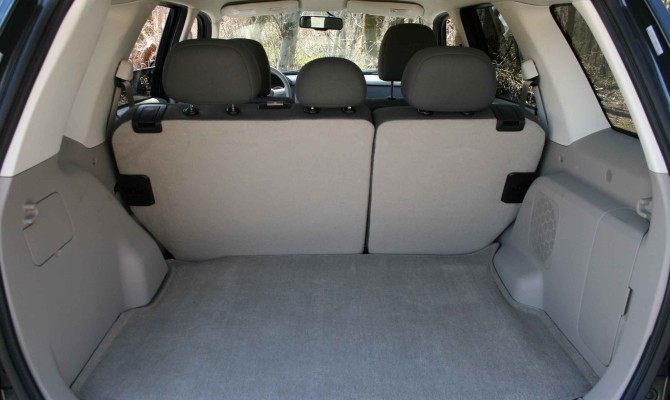The Escape’s reliability is generally rated average to better than average and repair costs are generally lower-than-average…
The Ford Escape is a founder member and a top-seller in the hot-selling compact utility club.
It came with a new-look exterior, an interior makeover and improved safety features for the 2008 model year, all included a complete second-generation redesign.
Although it doesn’t look too much different from its predecessor, the ’08 Escape has a wider stance and a slightly higher belt line than its predecessor and there are no carry-over body panels. A domed hood, bigger grille and new headlamps also give this Escape a slightly more aggressive look and it has better off-road attributes in terms of approach, break-over and departure angle capabilities.
A base front-drive Escape XLS is powered by a 2.3-litre engine. Moving up a step, the XLT trim allowed a 3.0-litre V6 option and a tow package that bumped trailer-hauling capability to 1,588 kg (3500 lb). The top-line Limited came with leather, dual climate control air conditioning and Audiophile sound system, more power features, and the V6 engine. Four-wheel-drive was an option with every trim level.
If an urban commute is your vehicles primary job and good fuel economy is important there’s also a hybrid version of the Escape. It has a smoother and quieter powertrain than the first generation Escape Hybrid, introduced in 2003, and its city-driven fuel economy rating is an ultra-frugal 5.7 L/100 km. It was also available in both front-drive and four-wheel-drive.
While stability control was standard on all gas-engine versions of the ’08 Escape, it wasn’t available on the Hybrid. Same story for a related new safety feature on the ’08, called Roll Stability Control (RSC). Particularly useful on taller vehicles, the RSC system automatically responds when a potential rollover is detected, by selectively applying brakes and/or decreasing the engine torque. Both of these important active safety features were made standard on the ‘09 and newer Escape Hybrid.
The ’09 model year also brought big changes under-hood. A new 2.5-litre 4-cylinder engine, a modified version of the 3.0-litre V6, two new transmissions and the hybrid got an even more refined drivetrain with an Atkinson cycle gasoline engine. The new five-speed manual transmission, in combination with the 4-cylinder engine, was only available in Escape models sold in Canada.
The Escape Hybrid is a full hybrid and capable of running purely on electric power up to about 40 km/hour. It also uses a continuously variable transmission (CVT). Although it doesn’t function with a conventional gear set, it still offers a low-range setting for challenging terrain.
The 2010 model year brought trim upgrades to Escape and all models got standard Blind Spot Mirrors. A top-line Limited trim was added to Escape Hybrid offerings and an Auto Park System, which automatically steers the Escape into a parallel parking spot, was a new option.
Ford Escape was essentially unchanged for 2011 and 2012, other than some new exterior colours and option packages. The 2012 model was the final year of this generation Ford Escape.
The Escape’s reliability is generally rated average to better than average and repair costs are generally lower-than-average, according to Consumer Reports. The Hybrid edition typically rates a little better. Resale prices are reasonable and there’s typically a good supply of used Ford Escape models out there. You can expect to pay an additional $2,000 to $4,000 for a Hybrid model.
**********
Price Check: 2008 – 2012 Ford Escape (June 2014)
Year Edition Expect to Pay Today
2008 XLT 4X4 $10,000 to $13,000
2009 XLT 4X4 $12,000 to $15,000
2010 XLT 4X4 $14,000 to $17,000
2011 XLT 4X4 $16,000 to $19,000
2012 XLT 4X4 $19,000 to $23,000
**********
Prices vary depending on a used vehicle’s condition, mileage, usage and history. A complete mechanical check should always be performed by a reliable auto technician prior to purchase.
**********
Safety Recalls: 2008 to 2012 Ford Escape:
2008/2009/2010/2011/2012: A fault in the Electric Power Steering (EPS) system could result in a sudden loss of power steering assist, without warning to the driver. This would significantly increase the effort required by a driver to steer at lower vehicle speeds. Dealers will affect repairs as necessary and reprogram the EPS controller with updated software.
2010: The automatic transmission’s park rod guide retention pin may not have been properly installed. This may prevent the transmission park pawl from engaging when shifted into “PARK” and allow vehicle movement. Dealers will inspect and, if necessary, install the missing park rod guide retention pin.
Recent Comments
- { Enjoyed your Forest of Bowland in the BMW X5M, particularly the photo of the BMW in front of the main part of Stonyhurst College where... }
- { Bantam designed the Jeep, not Willy's or Ford. The American military gave the original Bantam prototype to Willys and Ford to copy. There is plenty... }
- { All Escalades come with a 6.2-lilter V8 engine that produces 420 horsepower. A six-speed automatic is the only transmission offered and drives the rear wheels.... }
- { Alexandra is an excellent journalist. }
Popular Posts
- Journey to a ‘Sparkling’ Luxury Okanagan Resort “Four lucky readers will put a Dodge Journey’s weekend-...
- The Need For Speed: Hike Those Highway Limits More than half of those polled believe the province sho...
- Drives-U-Crazy… Erratic drivers. An early morning drive from Kelowna to Vancouver is nor...
- Readers Respond: The Pros and Cons of Increasing B.C. Speed Limits Increasing the speed limits will only increase risk to...
- Honda CR-V Review: The Compact Crossover To Get Things Done The CRV is a very stylish and aerodynamic crossover veh...












